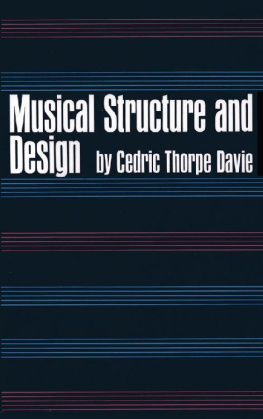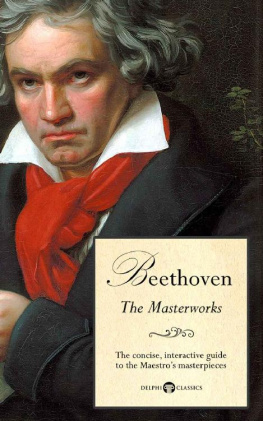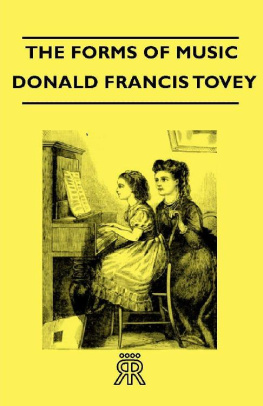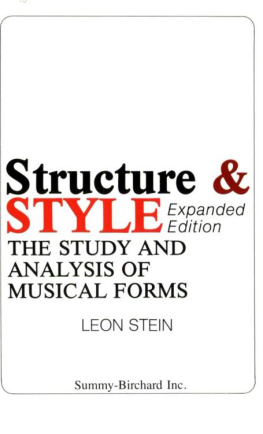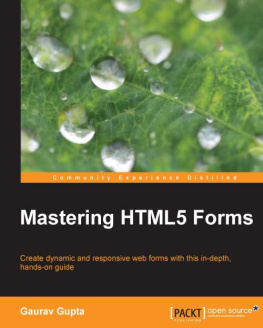MUSICAL
STRUCTURE
AND
DESIGN
CEDRIC THORPE DAVIE
A.R.C.M.
Head of Music Department,
University of St. Andrews
DOVER PUBLICATONS, INC.
NEW YORK
This Dover edition, first published in 1966, is an unabridged and unaltered republication of the work originally published by Dennis Dobson in 1953.
This edition is published by special arrangement with Dobson Books, Ltd., 80 Kensington Church Street, London W. 8, England.
International Standard Book Number: 0-486-21629-2
Library of Congress Catalog Card Number: 66-20421
eISBN-13: 978-0-48617-27-6-7
Manufactured in the United States by Courier Corporation
21629213
www.doverpublications.com
CONTENTS
FOREWORD
O NE WOULD BE tempted to describe Mr Thorpe Davie (after the conventional manner) as a rising young composer, were it not for the fact that he has risen. His music for three celebrated plays at the Edinburgh FestivalThe Three Estates, The Gentle Shepherd and The Highland Fairfor the Stratford productions of Henry VIII and King Lear, as well as other works, has won not only respect but affection. The reason is, of course, that Mr Thorpe Davie knows precisely how best to set out his music so that it may be intelligible. His musical aim, for which he is much in our gratitude, is clarity and not obscurity. We may suspect that his Scottish antecedents have had something to do with this. At any rate Scotland is confident that opinion which places him among the leaders of Scottish art represents enlightenment.
Clearly the structure and design of music is a musicians business. The creative artist knows so much more about it than the pedant or (dare we say?) the critic. The difficulty is that few composers are happy in literary expression. This one is an exception.
Therefore the student may turn to this work with confidence. He will find that much stock-in-trade information on form is composed of non sequiturs which, in turn, originate in fallacies. The emotional background to sonata, the relationas in the concertobetween habits of performance and musical style, the qualities of Haydn, Mozart and Purcell (in particular), the necessity for analysis by ear rather than by eye; these are some of the matters to receive treatment which can only stimulate the reader. So much music is critically reviewed that no one who has read this work with care will feel ill at ease in regard to the design of music.
Tovey is often quoted herein. The Tovey addict will find Mr Thorpe Davie congenial company. He will recognise much that Tovey did say and much that Tovey did not say. In short this book goes forward, even though in some respects it is bound to go backward
P.M.Y.
INTRODUCTION
E VER SINCE THERE have been men who have deliberately set out to compose pieces of music, and to give them a more or less permanent form by recording them in writing, they have been faced with one problem above all others. That problem arises at some point during the progress of the composition, and stated baldly, it takes the form of the question What shall I do next?
In some periods of musical history, various different satisfactory kinds of solution have been found. At other times, composers have been less sure of themselves. Indeed, practically the whole of one centurythe seventeenthwas devoted to the task of evolving, by the trial-and-error method, suitable ways of achieving continuity in that music employing instruments which (following on the invention and development of the violin family), replaced the hitherto prevailing purely vocal forms just about the end of the sixteenth century. Not that the composers of that day were conscious of being primarily concerned with any such thing; musical history shows that deliberate preoccupation with externals cannot of itself result in the production of masterpieces.
The aim of this book is to describe the answers which the best composers of different periods have given to the above question; to discuss the varying structural requirements of different musical styles, and to illustrate from the music itself the ways in which the greatest musical creative artists have met these requirements.
The most casual lover of music will find greater enjoyment in his listening if he has some understanding of the long- and short-range plans of the composer, for without it music can be only a matter of the momentary enjoyment of isolated sensations which happen to reach the seat of the emotions. To the serious music-student, whether he be an aspirant to the profession of music, or a listener determined to extract from the art as much as he can of that which so many great men have put into it, intimate and conscious understanding of design is even more important than close acquaintance with the technical details of harmony and counterpoint. For the composer, appreciation of the methods and achievements of his forerunners is the only sure foundation upon which he can build for himself.
To hear music and to listen to it are not necessarily the same thing. One can hear while thinking about something else, just as one can see things from the window of a bus while the attention is elsewhere; but listening requires continuous attention to the music, as a play requires continuous attention to the words and action.
Attentive listening is for several reasons much more widespread today than it was, say, fifty years ago. There is a more general understanding of the fact that great music is not something that has come into being, as it were by magic, through an intermediary known as a composer, but that it is the careful, thoughtful, and largely deliberate creation of men whose aptitude, inclination, studies and labour have all been concentrated on the creation of something which did not exist before. This realisation has led to an increase in the number of listeners who have found pleasure in doing justice to the creators of these new things by giving their work the close attention which it deserves.
This word attention is really the key to the whole matter. It is no very formidable task to devote ones mental energy for a short time to concentration upon the unfolding design of a piece of music, any more than it is to read a book; indeed, there are many similarities between attentive listening and attentive reading, and the student of music would do well to regard his listening as an occupation calling upon much the same faculties as his reading. The one essential difference lies in the need, in attentive listening, for exercising the memory to the extent of being able to recognise the re-appearance of passages already heard; but the development of this faculty is by no means difficult, and it is quickly improved by practice and experience. There is no need for alarm at early failures to recollect certain features of music that have been heard; ability to do so grows quickly, and is helped by the repeated hearings of the same piece which the gramophone makes possible.
The understanding, and therefore the study, of musical design (or form, or structure), is one of the essentials of intelligent attentive listening; but it brings with it a very real danger which the examination system, and the text-books written with that system in view, have tended to accentuate.
The authors experience has been, (great as is the number of books devoted in whole or in part to the subject of musical design, and excellent as is the quality of some of them), that too little stress is as a rule laid upon the fact that music is an art which includes time (measured in hours, minutes and seconds) among its elements; in other words, that it exists not on paper to be looked at, but in the time element to be listened to; that the printed copy is no more than a series of reminders or indications of what the music is intended to

